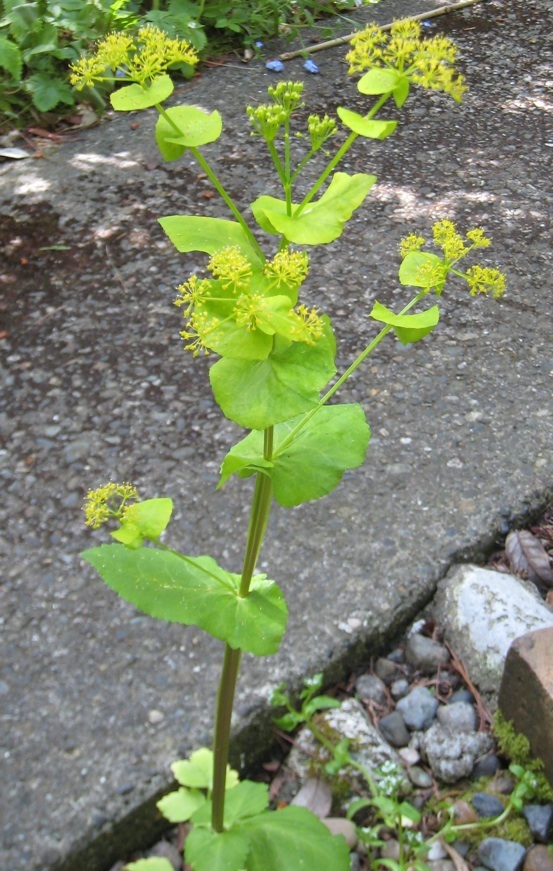Plant of the Month: May 2006
|
| Alexanders |
Smyrnium Olusatrum L.
|
UMBELLIFERÆ (APIACEÆ); Carrot Family
|
| Since the year 2000 I have grown Alexanders in my garden, as well as its close cousin Perfoliate Alexanders. This month I share my personal observations and library findings about the two plants. |
| Overall Alexanders ranks, to me, as not especially tasty, nor beautiful, and is weedy. It is moreover not regarded highly as a medicinal herb. In a word, it is second-rate. This opinion is not mine alone, as centuries ago Alexanders was cultivated a great deal more than it has been in the last two hundred years. Until about 1997 when I saw it grown at Sooke Harbour House's kitchen garden on Vancouver Island, I had never observed any on the West Coast. |
| The genus Smyrnium was named from the Greek smurna (myrrh), because of the aroma of the seeds. There are 7 or 8 species of Smyrnium, all Eurasian biennials or monocarpic perennials. Other genera in the Carrot family include Angelica, Levisticum (lovage), Heracleum (cow parsnip), Pastinaca (parsnip) and Petroselinum (parsley). |
| In 1753 the great biologist Linnæus published its specific name Olusatrum, an old name derived from the Latin olus (potherb or vegetable) and atrum (gloomy black), because of its seeds being notably large and utterly black. |
| Its native geographic range is primarily around the Mediterranean Sea. In some other parts of Europe it has been long naturalized, such as in the British Isles. |
| The English name Alexanders is in reference to either Alexandria, the city in Egypt founded by the ambitious Alexander the Great (356 - 323 B.C.) --or to Alexander's homeland, Macedonia in general. John Ray (1660; Catalogus Plantarum Angliae et Insularum Adjacentium) wrote "it was called Alexanders because in Italy and Germany it has long been denominated Herba Alexandrina having been supposed to have been brought from Alexandria (Egypt)." Other names recorded in English are Black Potherb, Black Lovage, Horse Parsley, Macedonian Parsley, Alick, Hell Root, Megweed, Skit, and Wild Celery. In French it is Maceron. |
| Historically, Alexanders was grown as both as a medicinal herb and gradually more so as a vegetable. It is most often compared to an inferior version of celery, essentially replaced by celery as the latter was steadily improved through selection of superior strains. All parts are edible. The flavor recalls celery, but with a bitterness. |
| Having grown both celery and Alexanders, I find the former more fussy, and yielding less mass. Essentially celery is tiny in its seeds, slow to sprout, and demands a rich, moist diet to be lush. In contrast, Alexanders boasts big seeds (a third of an inch) that sprout weedily, it is strong and large even without mucky soil, and has prettier flowers and seeds. But it is less succulent, a less pleasingly vibrant green, and its flavor has a less agreeable edge. |
| I bought a single plant from Goodwin Creek Gardens in 2000, and now have dozens sprung from it. Alexanders grows 3 to 5 feet high in my garden. At most it can reach 6 feet. The foliage is bold, each leaf is divided into three or more dark green toothed leaflets. The flowers are greenish-white, tiny, but abundant in softly rounded clusters during April and May. They are mildly, sweetly scented, and pollinated by flies, bees, wasps, and ants. In 1977 an English observer listed 137 different species of insects attracted to Alexanders flowers. It blooms earlier than most Carrot family plants, affording spring nectar. |
| Each seedling uses most of its energy to produce a plump root. When the root is large enough, after a year or two, the plant sends up its stout flowerstem. After making hundreds or thousands of seeds, it dies. Meanwhile, hard frost in the winter also discolors and kills any leaves. And a dry summer can make the plant wither and go dormant until rains resume in fall. |
Though usually near the sea in the wild, it can be grown in salty or non salty soil, alkaline (mostly) or acidic soil, part or full sun, and well drained or not well drained soil. It is not hard to grow, except where winters are too cold for it.
|
| Perfoliate Alexanders is Smyrnium perfoliatum L., a species grown as an ornamental, though it also is edible. I obtained a single plant in 2000, and found it superior to regular Alexanders. It is prettier in bloom, its cheerfully bright yellow-green flowers contrasting well with its green leaves. Its flavor is preferable. And in my garden at least it has not been weedy. But it has been a serious weed in England's Royal Botanic Garden, Kew, shading adversely the prized English Bluebells. |
| Its natural range is from the Atlantic Ocean to the Caucasus Mountains. Its appearance is very different than Alexanders. The seeds are smaller, wider, and merely dark brown. Though the basal leaves are trifoliate, the stem leaves are simple, deeply heart-shaped and clasp the flower stems. It blooms earlier in April, and is prized for its appearance both in bloom and by floral arrangers. |
It is smaller and is weaker than Alexanders. But is tastes better and looks better. I do not bother to blanch my Alexanders leaf stems or stalks, and if I did so, maybe the delicate flavor would impress me. All I do with both species is add fresh leaves, flowers or unripe seeds to salads or stir fry batches. I also enjoy chewing the highly flavorful, lovage-tasting big black seeds of Alexanders.
Back |

Alexanders flowers scan by ALJ
|

Alexanders flowers photo by ALJ
|

Alexanders leaf & seeds scan by ALJ
|

Perfoliate Alexanders photo by ALJ
|
|
|

